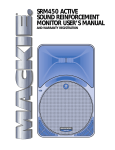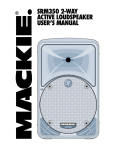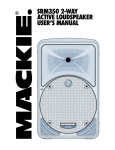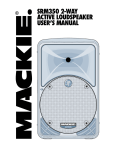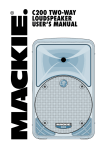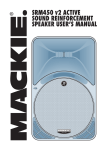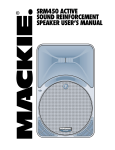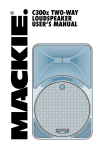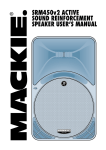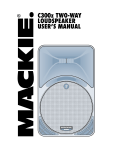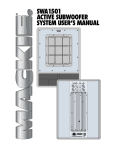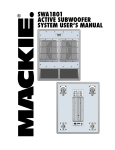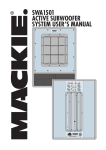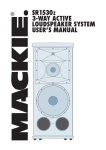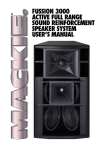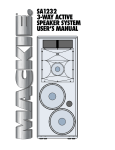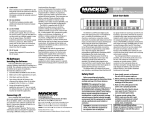Download Mackie SRM450 User`s manual
Transcript
SRM450 ACTIVE SOUND REINFORCEMENT SPEAKER USER’S MANUAL CAUTION AVIS RISK OF ELECTRIC SHOCK DO NOT OPEN RISQUE DE CHOC ELECTRIQUE NE PAS OUVRIR CAUTION: TO REDUCE THE RISK OF ELECTRIC SHOCK DO NOT REMOVE COVER (OR BACK) NO USER-SERVICEABLE PARTS INSIDE REFER SERVICING TO QUALIFIED PERSONNEL ATTENTION: POUR EVITER LES RISQUES DE CHOC ELECTRIQUE, NE PAS ENLEVER LE COUVERCLE. AUCUN ENTRETIEN DE PIECES INTERIEURES PAR L'USAGER. CONFIER L'ENTRETIEN AU PERSONNEL QUALIFIE. AVIS: POUR EVITER LES RISQUES D'INCENDIE OU D'ELECTROCUTION, N'EXPOSEZ PAS CET ARTICLE A LA PLUIE OU A L'HUMIDITE The lightning flash with arrowhead symbol within an equilateral triangle is intended to alert the user to the presence of uninsulated "dangerous voltage" within the product's enclosure that may be of sufficient magnitude to constitute a risk of electric shock to persons. Le symbole éclair avec point de flèche à l'intérieur d'un triangle équilatéral est utilisé pour alerter l'utilisateur de la présence à l'intérieur du coffret de "voltage dangereux" non isolé d'ampleur suffisante pour constituer un risque d'éléctrocution. The exclamation point within an equilateral triangle is intended to alert the user of the presence of important operating and maintenance (servicing) instructions in the literature accompanying the appliance. Le point d'exclamation à l'intérieur d'un triangle équilatéral est employé pour alerter les utilisateurs de la présence d'instructions importantes pour le fonctionnement et l'entretien (service) dans le livret d'instruction accompagnant l'appareil. SAFETY INSTRUCTIONS 1. Read Instructions — All the safety and operation instructions should be read before this Mackie product is operated. 2. Retain Instructions — The safety and operating instructions should be kept for future reference. 3. Heed Warnings — All warnings on this Mackie product and in these operating instructions should be followed. 8. Heat — This Mackie product should be situated away from heat sources such as radiators, or other devices which produce heat. 9. Power Sources — This Mackie product should be connected to a power supply only of the type described in these operation instructions or as marked on this Mackie product. 10. Power Cord Protection — Power supply cords should be routed so that they are not likely to be walked upon or pinched by items placed upon or against them, paying particular attention to cords at plugs, convenience receptacles, and the point where they exit this Mackie product. 11. Object and Liquid Entry — Care should be taken so that objects do not fall into and liquids are not spilled into this Mackie product. 12. Damage Requiring Service — This Mackie product should be serviced only by qualified service personnel when: A. The power-supply cord or the plug has been damaged; or B. Objects have fallen, or liquid has spilled into this Mackie product; or C. This Mackie product has been exposed to rain; or D. This Mackie product does not appear to operate normally or exhibits a marked change in performance; or E. This Mackie product has been dropped, or its chassis damaged. 13. Servicing — The user should not attempt to service this Mackie product beyond those means described in this operating manual. All other servicing should be referred to the Mackie Service Department. 4. Follow Instructions — All operating and other instructions should be followed. 14. To prevent electric shock, do not use this polarized plug with an extension cord, receptacle or other outlet unless the blades can be fully inserted to prevent blade exposure. 5. Water and Moisture — This Mackie product should not be used near water – for example, near a bathtub, washbowl, kitchen sink, laundry tub, in a wet basement, near a swimming pool, swamp or salivating St. Bernard dog, etc. Pour prévenir les chocs électriques ne pas utiliser cette fiche polariseé avec un prolongateur, un prise de courant ou une autre sortie de courant, sauf si les lames peuvent être insérées à fond sans laisser aucune pariie à découvert. 6. Cleaning — Clean only with a dry cloth. 15. Grounding or Polarization — Precautions should be taken so that the grounding or polarization means of this Mackie product is not defeated. 7. Ventilation — This Mackie product should be situated so that its location or position does not interfere with its proper ventilation. For example, the Component should not be situated on a bed, sofa, rug, or similar surface that may block any ventilation openings, or placed in a built-in installation such as a bookcase or cabinet that may impede the flow of air through ventilation openings. PORTABLE CART WARNING Carts and stands - The Component should be used only with a cart or stand that is recommended by the manufacturer. A Component and cart combination should be moved with care. Quick stops, excessive force, and uneven surfaces may cause the Component and cart combination to overturn. 2 16. Power Precaution — Unplug this Mackie product during lightning storms or when unused for long periods of time. Note that this Mackie product is not completely disconnected from the AC mains when the power switch is in the OFF position. 17. This apparatus does not exceed the Class A/Class B (whichever is applicable) limits for radio noise emissions from digital apparatus as set out in the radio interference regulations of the Canadian Department of Communications. ATTENTION —Le présent appareil numérique n’émet pas de bruits radioélectriques dépassant las limites applicables aux appareils numériques de class A/de class B (selon le cas) prescrites dans le règlement sur le brouillage radioélectrique édicté par les ministere des communications du Canada. WARNING — To reduce the risk of fire or electric shock, do not expose this appliance to rain or moisture. Lend Me Your Ears Exposure to extremely high noise levels may cause permanent hearing loss. Individuals vary considerably in susceptibility to noise-induced hearing loss, but nearly everyone will lose some hearing if exposed to sufficiently intense noise for a period of time. The U.S. Government’s Occupational Safety and Health Administration (OSHA) has specified the permissible noise level exposures shown in this chart. Duration Per Day Sound Level dBA, In Hours Slow Response 8 90 6 92 4 95 3 97 2 100 1.5 102 1 105 0.5 110 0.25 or less 115 According to OSHA, any exposure in excess of these permissible limits could result in some hearing loss. To ensure against potentially dangerous exposure to high sound-pressure levels, it is recommended that all persons exposed to equipment capable of producing these levels use hearing protectors while this unit is in operation. Ear plugs or protectors in the ear canals or over the ears must be worn when operating this amplification system in order to prevent a permanent hearing loss if exposure is in excess of the limits set forth here. Typical Example Duo in small club Subway Train Very loud classical music The SRM450 can produce a maximum SPL of 127 dB @ 1m. Tami screaming at Adrian about deadlines Loudest parts at a rock concert CONTENTS INTRODUCTION ....................................................... 4 HOOKUP DIAGRAMS ............................................... 6 Quick Start ........................................................ 6 REAR PANEL DESCRIPTION .................................... 8 IEC Socket .................................................. 8 POWER Switch ............................................ 8 POWER ON Indicator ................................... 8 TIMED TURNOFF ......................................... 8 THERMAL Indicator ..................................... 8 CONTOUR .................................................. 9 LOW CUT .................................................... 9 LEVEL ......................................................... 9 SIGNAL PRESENT Indicator ........................ 9 PEAK Indicator ............................................ 9 INPUT Connector ........................................ 9 THRU Connector ......................................... 9 ACCESSORY Plate ...................................... 9 CONNECTIONS ...................................................... PLACEMENT .......................................................... RIGGING ................................................................ THERMAL CONSIDERATIONS ................................ AC POWER CONSIDERATIONS .............................. SERVICE INFORMATION ........................................ Warranty Service ............................................. Troubleshooting ............................................... Repair ............................................................. CARE AND MAINTENANCE .................................... SRM450 SPECIFICATIONS ..................................... SRM450 BLOCK DIAGRAM .................................... SRM450 LIMITED WARRANTY ............................... Don’t forget to visit our website at www.mackie.com for more information about this and other Mackie products. Part No. 820-158-90 Rev. A 10/03 ©2003 LOUD Technologies Inc. All Rights Reserved. 3 10 10 11 12 12 14 14 14 16 16 17 18 19 INTRODUCTION Thank you for choosing LOUD Technologies’ Mackie active sound reinforcement speakers. The SRM450 is an active two-way loudspeaker capable of extremely high sound pressure levels, and designed to give you the best performance of any loudspeaker in its class and price range. Our design goal was to build a sound reinforcement speaker with: 1. High precision, high output, and accurate playback. 2. Very wide, smooth dispersion of mid and high frequencies. 3. Ergonomically correct physical design for easy transport and set up. Through the combined resources of our top-notch mechanical and analog engineers, and our experienced transducer engineers at RCF, our transducer manufacturing facility in Italy, we were able to achieve our design goals in every aspect. The result is a sound reinforcement system equally at home in a concert setting, in the studio, impromptu concerts on the studio roof, in the cinema, or in a home theater. The Transducers The SRM450 active speakers feature a 12-inch high-power low-frequency woofer and a 1.75-inch titanium diaphragm highoutput precision compression driver. This high-frequency driver is mounted on an acoustically non-resonant exponential waveguide, providing a wide, controlled dispersion and precise reproduction of the critical upper mid-range and high frequencies. The result is an unbelievably smooth off-axis response that allows everyone in the audience to experience the same highresolution audio no matter where they are seated. Each driver has been specifically designed by our engineers for optimum performance in the lightweight high-strength cabinet. 4 FR Series Power Amplifiers To power these beautiful things, each SRM450 includes two of our acclaimed FR Series “Fast Recovery” power amplifiers. Our exclusive design uses low negative feedback, yet allows the amplifiers to maintain low distortion and stability and to quickly recover when driven into clipping. The amplifiers include the following features: • The low-frequency amplifier produces up to 540 watts peak (300 continuous) before clipping. • The high-frequency amplifier produces up to 150 watts peak (100 continuous) before clipping. • Each amplifier has its own compressor circuit that acts when the input signal is large enough to cause clipping, distortion and excessive voice coil heat. The compressor will automatically decrease the input signal to a safe level. The compressor in the low-frequency amp works independently from that in the high-frequency amp. • The low-frequency amp uses a servo feedback loop which senses the current flowing in the woofer coil. This controls the low-frequency response and maintains low distortion at high output levels. • The low-frequency amplifier also has a sweeping filter. This will automatically move the low cut-off frequency up or down depending on the amplifier output. For example, if the amplifier is below clipping, the low-frequency cutoff point is 55 Hz. As it approaches clipping, this shifts up smoothly to 120 Hz, providing more power reserves and less distortion before clipping. This happens quickly and continuously, protecting the amplifer and the woofer and reducing any noticable distortion. Warning: Although the amplifiers have these protection circuits, you must still make sure the PEAK light is not blinking continuously. If it is, turn down your mixer faders, or preamplifier gain, or turn down the SRM450 LEVEL control. The Crossover The Active Advantage The built-in electronic crossover is a 24 dB/octave Linkwitz-Riley design. Although more expensive than other crossover designs, the benefits provided by the Linkwitz-Riley design have been well documented. These benefits include: • Absolutely flat frequency response throughout the bandpass, without the characteristic ripple near the crossover point exhibited by other designs. • The sharp 24 dB per octave roll-off of the filters ensures that the transducers aren’t reproducing frequencies outside of their capabilities. • The acoustic sum of the two driver responses is unity at the crossover frequency, resulting in perfect power response. • Our heroic engineers have worked carefully to ensure that the SRM450 also provides perfect phase response. This diligence has yielded phenomenal accuracy, even if you are standing 20 feet away. There are a number of advantages to using an active speaker system over a passive loudspeaker: • The internal crossover is active, and its low power circuitry operates on linelevel signals. It does not waste speakerlevel power like a passive crossover with large coils, caps, and resistors. • The input signals are crossed over before they reach the amplifiers, so each amplifier only receives the correct frequency range for its driver. • The amplifiers are designed specifically for these speaker load impedances. There is no guesswork as to what load each amplifier has to drive, so they can provide maximum acoustic output from the speakers, yet minimize the danger of speaker damage due to overdriving a lesser amplifier. • The connecting wires between the amplifier outputs and the drivers are kept to a minimum, so the damping factor of the amplifier isn’t compromised by the resistance of long speaker cables. In addition, all the power from the amplifier is transferred directly to the drivers with no speaker cable losses. • The acoustic sum of the outputs from the two drivers is optimized electronically, as well as physically, so the amplitude response is flat and there is no lobing error. • The presence of active circuits within the speaker cabinet allow the designer to add on extra details, such as a high quality mic/line input section and optional accessory modules. In short, all the complex interconnected components in the system are designed to work in harmony with each other to produce the best possible sound. (Even for Uncle Bert’s star performance on spoons!) The Cabinet The SRM450 cabinet was designed to be the strongest molded composite cabinet on the planet. This material is as strong as concrete, and rigid enough to prevent unwanted vibrations in the cabinet. It has built-in fly points for hanging, and a socket in the bottom for mounting on a tripod stand. Although it is an exceptional choice for installed sound situations, its light weight and durable finish also make it ideal for portable sound system use. The asymmetrical trapezoidal design of the cabinet makes it easy to use as a floor wedge for stage monitor applications. 5 HOOKUP DIAGRAMS Quick Start 1. Start with the following settings on the back of the SRM450: Turn the POWER switch off (down). Set the TIMED TURNOFF, CONTOUR, and LOW CUT switches out. WARNING: Turn the LEVEL control down (counterclockwise) before every use. If not, you could be in for a startling surprise, especially if the last time you used it was with a microphone and now you want to connect a linelevel source. 2. Connect the output from your signal source (mixing console, microphone, preamp, or other mic- or line-level source) directly to the INPUT connector on the back of the SRM450. It accepts balanced line-level signals from mixers, preamplifiers, CD players, tape decks, etc., and accepts direct connections from dynamic microphones. DESIGNED BY MACKOIDS IN WOODINVILLE, WA • USA DESIGNED BY MACKOIDS IN WOODINVILLE, WA • USA DESIGNED BY MACKOIDS IN WOODINVILLE, WA • USA DESIGNED BY MACKOIDS IN WOODINVILLE, WA • USA 3. Connect the supplied AC power cord to the IEC socket on the back of the SRM450. Plug the other end into an AC outlet properly configured with the correct voltage for your particular model. 4. Turn on your signal source. Make sure its Master Volume control (if it has one) is turned all the way down. 5. Turn on the SRM450 POWER switch. 6. Start the signal source, whether it be speaking into a microphone or starting a CD player. Adjust any volume controls on the signal source for normal operation. 7. Slowly turn up the LEVEL control on the back of the SRM450 until the desired volume is reached (and the PEAK light does not come on). Always wear hearing protectors if you are close when it is playing at high levels. 8. If there is no sound, always turn down the SRM450 LEVEL control before investigating. There may be a mixer or preamplifier mute or tape switch engaged, or a mic switch off. DESIGNED BY MACKOIDS IN WOODINVILLE, WA • USA Left Line level Output DESIGNED BY MACKOIDS IN WOODINVILLE, WA • USA Next Next DESIGNED BY MACKOIDS IN WOODINVILLE, WA • USA DESIGNED BY MACKOIDS IN WOODINVILLE, WA • USA Thru Thru 1202-VLZ PRO Right Line level Output 1202-VLZ PRO Mixer or Preamplifier Daisy-chaining SRM450s SRM450: STEREO OPERATION WITH A MIXER, AND USING THE THRU JACK 6 For microphone connections, you can daisy-chain up to two SRM450s using the THRU jacks as shown. Take great care to point any microphones away from the SRM450s, otherwise you may get feedback. Dynamic Microphone DESIGNED BY MACKOIDS IN WOODINVILLE, WA • USA DESIGNED BY MACKOIDS IN WOODINVILLE, WA • USA THRU Output SRM450: USING A MICROPHONE AND THE THRU JACK The SRM450 can be used with a Mackie SWA1501 (or SWA1801) subwoofer to create an incredibly powerful system. The active crossover inside the SWA1501 splits the full-range input signal into two ranges. The SWA1501 plays the low-frequency range through its 500 watt amplifier and 15-inch woofer, and sends the high-pass range to the SRM450. The SRM450 can be pole mounted on top of the SWA1501 as shown, saving the cost of a tripod stand. Pole Mount Line-level Hi-pass out Pole Mount Power Cord Line-level Hi-pass out ACTIVE Full Range Power Cord ACTIVE Full Range 1202-VLZ PRO Power Cords SWA1501 plays the low frequencies Power Cords SWA1501 plays the low frequencies SRM450: BIAMPING WITH A POWERED SUBWOOFER 7 REAR PANEL DESCRIPTION The SRM450 has several connectors, controls, and indicators that you should understand. IEC Socket This is where you connect the supplied AC linecord to provide AC power to the SRM450’s built-in power amplifiers. Plug the linecord into an AC socket properly configured for your particular model. Note: If you happen to lose the AC linecord, replacements are readily available at any office or computer supply store. Always use a three-pin plug with a ground pin. POWER Switch Switch up to turn the SRM450 on, and switch down to turn it off. Make sure the level control is down before you turn it on. POWER ON Indicator When the POWER switch is turned on, and the linecord is connected to an active AC Mains supply, this indicator, located just above the POWER switch, glows to let you know that you’re ready to rock and roll. The cool blue LED on the front of the speaker works in the same way. DESIGNED BY MACKOIDS IN WOODINVILLE, WA • USA 8 TIMED TURNOFF When this switch is pushed in, the builtin amplifiers turn on and off depending on the presence or absence of an input signal. An input signal level of –45 dBu (minimum) activates the auto-on function. A silent period greater than three minutes activates the auto-off function. The blue LED on the front of the speaker reflects the state of the amplifiers. THERMAL Indicator This LED lights if the heatsink temperature exceeds a safe operating temperature and triggers the thermal safety switch. When this occurs, the built-in amplifiers shut down until the heatsink temperature cools back down. Then the thermal switch resets itself, the THERMAL indicator turns off, and normal operation resumes. If the SRM450 keeps shutting down, make sure there is plenty of ventilation to the rear panel. Please see “Thermal Considerations” on page 12. CONTOUR Pushing in this switch engages a filter that provides 3 dB of boost to the low and high frequencies (below 100 Hz and above 12 kHz). This provides a punchy, crisp sound for most live music applications. You can experiment with this switch by leaving it out for a while, then pushing it in to determine which way sounds best for your application. It is especially useful when listening at lower volumes, as it highlights the bass like a Loudness switch, in addition to boosting the highs. LOW CUT Pushing in this switch engages a low-cut filter, which rolls off the low frequencies below 75 Hz. This is useful for minimizing stage noise (rumble) and microphone handling noise. It is highly recommended that you engage this switch when using the SRM450 as a stage monitor. This allows the bass amplifier to utilize its power for those frequencies useful in stage monitor applications. LEVEL This is used to adjust the signal level, going into the built-in power amplifiers, from Off up to 40 dB of gain. Since the SRM450 incorporates Mackie’s world-class low-noise mic preamp technology, you can connect either a line-level or a microphone-level signal to the input, and use this control to adjust the level correctly. There is no phantom power for a microphone, so you should use a dynamic mic, or use a condensor type if it has its own battery power. Follow the Quick Start guide on page 6 for setting the LEVEL control. For most applications, it will be in the NORMAL position (12 o’clock). If you have a particularly high line-level signal connected to the SRM450, you may need to turn the control down to the LINE indication (9 o’clock). If you have a low line-level or mic-level signal connected, you may need to turn the LEVEL control up to the MIC indication (3 o’clock). SIGNAL PRESENT Indicator This LED illuminates whenever there is a signal present at the INPUT connector on the rear panel. It senses the signal just prior to the LEVEL control, so even if the LEVEL control is turned down, the SIGNAL PRESENT indicator still works. PEAK Indicator When the signal levels at the amplifier outputs approach clipping, a soft compression circuit is activated that reduces the input signal. The PEAK LED lights whenever the compression circuit is active. At this time, the SRM450 may reach sound pressure levels of 120 dB or more. It’s okay for the PEAK indicator to blink occasionally, but if it blinks frequently or continuously, either turn down the signal level at the mixer or other signal source, or turn down the SRM450’s LEVEL control. Wear hearing protection if you are close to the SRM450 playing at high levels. INPUT Connector This is a female XLR-type connector that accepts a balanced or unbalanced mic- or line-level signal. THRU Connector This is a male XLR-type connector that produces exactly the same signal that is connected to the INPUT jack. It can be a balanced or unbalanced mic- or line-level signal. Use it to daisy-chain several active speakers together off the same signal source. ACCESSORY Plate This removable plate provides access to install future accessory modules. 9 CONNECTIONS PLACEMENT The SRM450 has a female XLR input that accepts a balanced or unbalanced micor line-level signal. When connecting a balanced signal, be sure it’s wired per AES (Audio Engineering Society) standards: The SRM450 active speakers are designed to sit on the floor, a tabletop, or to fit on a standard tripod speaker stand. They can also be suspended by the rigging points, shown opposite. You can lay the cabinet down on its side and use the SRM450 as a floor monitor. The asymmetrical trapezoidal shape of the cabinet provides a perfect angle for aiming up toward performers from the front of the stage. When used for monitor applications, we recommend engaging the LOW CUT filter. Hot (+) Cold (–) Shield (Ground) XLR Pin 2 Pin 3 Pin 1 There is also a male XLR connector labeled THRU. This allows you to connect more than one SRM450 to the output of your mixing console. Simply plug the signal source output into the first INPUT jack, and patch that speaker’s THRU jack to the next INPUT jack, and so on, daisy-chaining multiple speakers (see diagram on page 6). There is a limit to how many you can daisy-chain together. A general rule is to maintain a load impedance ten times or more than the source impedance to prevent excessive loading on the source. For example, if your mixer has an output impedance of 120 ohms, then you can daisy chain up to sixteen SRM450s. This is a load of 1250 ohms (SRM450 input impedance=20 kohms; 16 of these in parallel=1250 ohms). Since microphones typically have a higher output impedance, you should limit daisy-chaining from a mic source to two SRM450s (see the diagram on page 7). The THRU jack is wired straight from the INPUT connector — there is no electronic circuitry between — so the signal coming out of the THRU jack is exactly the same as the signal going in. As with any powered components, protect them from moisture. If you are setting them up outdoors, make sure they are under cover if you expect rain. The SRM450 generates magnetic fields. Do not place them closer than two or three feet (60–100 cm) from TV or computer monitors. Check the screen for any change in color or distortion. Do not place any magnetic audio or video tapes or computer discs near the SRM450s. Room Acoustics The SRM450 active speakers are designed to sound as neutral as possible; that is, to reproduce the input signal as accurately as possible, monitoring the sound rather than changing it. Room acoustics play a crucial role in the overall performance of a sound system. However, the wide high-frequency dispersion of the SRM450 helps to minimize the problems that typically arise. Balanced XLR Connectors Top 900 900 Dispersion up to 20 kHz 10 Here are some other placement tips: • Avoid placing loudspeakers in the corners of a room. This increases the low-frequency output and can cause the sound to be muddy and indistinct. • Avoid placing loudspeakers against a wall. This, too, increases the low frequency output, though not as much as corner placement. However, if you do need to reinforce the low frequencies, this is a good way to do it. • Avoid placing the active speakers directly on a hollow stage floor. A hollow stage can resonate at certain frequencies, causing peaks and dips in the frequency response of the room. It’s better to place the active speakers on a sturdy table or tripod stands. • Position the active speakers so the highfrequency drivers are two to four feet above ear level for the audience (make allowances for a standing/dancing in the aisles audience). High frequencies are highly directional and tend to be absorbed much easier than lower frequencies. By providing direct line-ofsight from the active speakers to the audience, you increase the overall brightness and intelligibility of the sound system. • Highly reverberant rooms, like many gymnasiums and auditoriums, are a nightmare for sound system intelligibility. Multiple reflections off the hard walls, ceiling, and floor play havoc with the sound. Depending on the situation, you may be able to take some steps to minimize the reflections, such as putting carpeting on the floors, closing draperies to cover large glass windows, or hanging tapestries or other materials on the walls to absorb some of the sound. However, in most cases, these remedies are not possible or practical. So what do you do? Making the sound system louder generally doesn’t work because the reflections become louder, too. The best approach is to provide as much direct sound coverage to the audience as possible. The farther away you are from the speaker, the more prominent will be the reflected sound. Use more speakers strategically placed so they are closer to the back of the audience. If the distance between the front and back speakers is more than about 100 feet, you should use a delay processor to time-align the sound. (Since sound travels about 1 foot per millisecond, it takes about 1/10 of a second to travel 100 feet). RIGGING The SRM450 cabinets are fitted with ten rigging points as shown in the diagram below. These are M10 inserts. M10 threaded eyebolts (M10 x 1.5 mm x 20 mm) are available to fit these inserts (PA-A1 Eyebolts). WARNING: Never attempt to suspend the SRM450 active speakers by their handles. If you want to suspend them, use the rigging points only. Consult a professional rigger or structural engineer prior to suspending loudspeakers from a structure not intended for that use. Always know the working load limit of the structure supporting the loudspeaker array. Always make sure that the rigging hardware minimum rating is at least five times the actual load. Back Both Sides SRM450 Pole Mount Top Rigging Points Bottom If you are hanging them in an inaccessable place, such as over a lion’s cage, make sure that you first complete the sound check and set the SRM450 LEVEL correctly. Also set the TIMED TURNOFF switch if you want the SRM450 to turn on when there is a signal present. It will also turn off after three or more minutes of silence. 11 THERMAL CONSIDERATIONS AC POWER CONSIDERATIONS The amplifiers inside the SRM450 are convection cooled by a large heatsink. For efficient cooling, it is important to allow at least six inches of free space behind the SRM450. If you use the SRM450 on its side for stage monitor applications, we highly recommended that you engage the rear panel LOW CUT switch. This will allow more power for useful monitor frequencies, while reducing the possibility of overheating. If the ambient temperature in the room is high, it could cause the amplifiers to overheat. In this case, you should try aiming a fan at the heatsink to increase the air flow through the fins. During a performance, don’t have it cranked so high that the rear panel PEAK LED is blinking frequently or lighting continuously. You should turn down the LEVEL control a notch or two to avoid overheating the amplifiers or your neighbors. If the amplifiers do overheat, a built-in thermal switch will activate, placing the amplifiers into standby. When the amplifiers have cooled down to a safe operating temperature, the thermal switch will reset and the SRM450 will resume normal operation. Be sure the SRM450 is plugged into an outlet that is able to supply the correct voltage specified for your model. If the voltage should drop below 97% of the specified line voltage, the built-in amplifiers will no longer be able to supply rated power. (They will continue to operate down to 75% of the rated line voltage, but won’t reach full power, resulting in lower headroom). Under maximum S.P.L. conditions, where musical peaks are clipping, the SRM450 120V model draws 2.5 amps on average (1.3 amps for the 240V model). Under normal conditions, the current draw is below 1 amp. We recommend that a stiff (robust) supply of AC power be used because the amplifiers place high current demands on the AC line. The more power that is available on the line, the louder the speakers will play and the more peak output power will be available for cleaner, punchier bass. A suspected problem of “poor bass performance” is often caused by a weak AC supply to the amplifiers. HEATSINK LOW CUT AC Power Distribution A 240VAC center-tapped service entrance transformer serves the majority of AC outlets encountered in homes and clubs (in the U.S.). This provides two phases of AC power on either side of the center tap, at 120V each. If lighting is used in a show, it is preferable to power the lights from one leg of the service, and power the audio equipment from the other leg. This will help minimize noise from the lights coupling into the audio (particularly if SCRs, or light-dimmer switches, are used). HIGH VOLTAGE POWER LINE PEAK THERMAL 120V PRIMARY WINDING 240V 120V TRANSFORMER DESIGNED BY MACKOIDS IN WOODINVILLE, WA • USA 240V CENTER-TAPPED SECONDARY 12 EARTH GROUND (NEUTRAL) SECONDARY WINDING Wherever possible, connect all of your equipment to the same electrical circuit. This will help reduce the possibility of a ground loop problem causing an annoying hum in your speakers. Low power components such as tape decks, mixers, effects processors and CD players should be connected to the same outlet as the SRM450s. Use fused power strips as shown in the diagram below. Make sure that the total current draw of your components does not exceed the capability of the outlets and power strips. For the US 120 V model: A maximum of five SRM450s can be connected per 15A service. This allows each SRM450 to be safely operated at its maximum level. When setting up for a show, often you are plugging into an AC power distribution system you know nothing about. You may even be faced with 2-wire outlets that are missing the third safety ground pin. It’s a good idea to have a three-wire AC outlet tester in your toolbox so you can check the outlets yourself to make sure they are wired correctly. These testers will tell you if the polarity of the hot and neutral wires is reversed and if the safety ground is disconnected. Don’t use an outlet if it is wired improperly! This is to protect yourself as well as your equipment. When turning your system on, turn on the SRM450s last. This will stop any turnon thumps and bangs from your source equipment being amplified. When turning off your system, turn off the SRM450s first. This will prevent any turn-off thumps and bangs from your source equipment being amplified. SRM450 Never remove the ground pin on the power cord of the SRM450 or any other component. This is very dangerous. SRM450 SRM450: AC CONNECTIONS 13 SERVICE INFORMATION Warranty Service Details concerning Warranty Service are spelled out on page 19 of this manual. If you think your loudspeaker has a problem, please do everything you can to confirm it before calling for service, including reading through the following troubleshooting section. Doing so might save you from being deprived of your Mackie loudspeaker. If you do find the problem, make sure that you turn down the LEVEL controls and turn off the SRM450 before correcting it or changing any connections. Of all Mackie products returned for service (which is hardly any at all), many are coded “CND” — Could Not Duplicate— which usually means the problem lay somewhere else in the system. The following troubleshooting tips may sound obvious, but here are some things you can check: Troubleshooting No power! • Our favorite question: Is it plugged in? Make sure the AC outlet is live (check with a tester or lamp). • Our next favorite question: Is the POWER switch on? If not, try turning it on. • Is the blue light on the front panel illuminated? If not, make sure the AC outlet is live. If so, refer to “No sound” below. • The AC line fuse inside the chassis is blown. This is not a user-serviceable part. Refer to “Repair” on page 16 to find out how to proceed. No sound! • Is the input LEVEL control turned all the way down? Follow the procedures in the “Quick Start” section on page 6 to verify that all the volume controls in the system are properly adjusted. • Is the signal source working (and making union scale)? Make sure the connecting cables are in good repair and securely 14 connected at both ends. Make sure the output volume (gain) control on the mixing console or preamp is turned up sufficiently to drive the inputs of the speaker. You should be able to see the SIGNAL PRESENT LED blink on the rear panel. • Make sure the preamp or mixer does not have a Mute on, or a Tape or Processor loop engaged. If you find something like this, make sure the volume/gain is turned down before disengaging the offending switch. • Is the THERMAL LED lit? Make sure there is at least six inches of free space behind the heatsinks. Allow the SRM450 to cool off and it will turn back on. One side is way louder than the other! • Are the LEVEL controls set the same on both active speakers? • Check the PAN control or balance on the signal source. It may be turned too far to one side. If you’re using a stereo signal source, it may be delivering an out-of-balance stereo signal. • Try swapping sides: Turn off the active speakers, swap the input cables coming from the mixing console, turn the active speakers back on. If the same side is still louder, the problem may be with your active speakers or cables between the mixer and the active speaker. If the other side is louder now, the problem is with the mixer or the signal source. Poor bass performance • Check the polarity of the connections between the mixer/preamp and the active speakers. You may have your positive and negative connections reversed at one end of one cable, causing one SRM450 to be out-of-phase. As soon as the music gets loud, the SRM450 shuts down! • Be sure that the PEAK LED on the rear panel is not lighting up frequently or continuously. Remember to wear ear protectors if you get close to an SRM450 playing at high levels. When the PEAK LED comes on, the SPL is in a region above 120 dB!!! • Make sure there is room behind the rear panel to provide sufficient ventilation to the heatsink. Bad sound! • Is it loud and distorted? Follow the procedures described in the “Quick Start” section to verify that the levels are set properly. • Is the input connector plugged completely into the jack? Be sure all connections are secure. It’s a good idea to periodically clean all electrical connections with a non-lubricating electrical contact cleaner. Noise • Make sure all connections to the active speakers are good. • Make sure none of the signal cables are routed near AC cables, power transformers, or other EMI-inducing devices. • Is there a light dimmer or other SCRbased device on the same AC circuit as the SRM450? Use an AC line filter or plug the SRM450 into a different AC circuit. the unbalanced-to-balanced interface between the devices (and exacerbated by the fact that most consumer audio equipment have a two-wire linecord, without the third-pin safety ground). Use an interconnect cable wired as shown below. The important point is that the shield and the wire from the XLR pin 3 are joined at the RCA (source) end. RCA XLR 3-Conductor Cable 2 1 3 shield • Disconnect any cables which come in from outside, such as cable TV, satellite TV or roof top antennas. They must be disconnected from every part of your system, such as the TV, VCR and preamp. If the hum goes away, you can add a “ground loop isolator” in your cable line. This is an inexpensive device available from video or TV dealers, or you can make your own from two TV baluns (standard TV 75/300 ohm adaptors): Hum • Turn the LEVEL control all the way down. If the noise disappears, it’s coming from the signal source. If not, try disconnecting the cable connected to the INPUT jack. If the noise disappears, it could be a “ground loop,” rather than a problem with the SRM450. Try some of the following troubleshooting ideas: • Use balanced connections throughout your system for the best noise rejection. • Whenever possible, plug all the audio equipment’s linecords into outlets which share a common ground (see the diagram on page 13). The distance between the outlets and the common ground should be as short as possible. Never remove the ground pin on the power cord of the SRM450 or any other component. This is very dangerous. • The hum may appear when using an unbalanced source (consumer preamp, CD player, VCR, etc.). This is caused by Balun join (+insulate) Balun The baluns are threaded at one end (75 ohm) to fit TV coax cable and have two wires at the other end (300 ohm). They will not affect the video quality. • If the hum persists, try removing components one at a time from the back of the mixer or preamplifier, and check for hum each time (turn off your equipment before you undo any connections). It is fairly common to find more than one problem. • If your preamp or mixer are the only things connected to the SRM450s and the hum is still there, try different connection cables, or move the preamp/ mixer to another location. • Pressing the LOW CUT FILTER may help reduce the hum if you have trouble finding the cause of the problem. Do this anyway if you do not need to reproduce the lower frequency range. 15 REPAIR Service for the SRM450 is available only from one of our authorized domestic service stations or at the factory, located in sunny Woodinville, Washington. Service outside the United States can be obtained through local dealers or distributors. If your SRM450 needs service, please follow these instructions: 1. Review the preceding troubleshooting suggestions. Please. 2. Call Tech Support at 1-800-258-6883, 7 AM to 5 PM PST, to explain the problem in detail. They will ask you all sorts of impertinent questions in the hope of sorting out the problem. If it appears that the SRM450 needs repair, request an RA (Return Authorization) number. Have your speaker’s serial number ready. You must have an RA number before you can obtain service at the factory or an authorized service center. 3. Keep this owner’s manual and detachable linecord. We don’t need them to repair the loudspeaker. 4. Pack the loudspeaker in its original package, including protective wrap, endcaps, and box. This is very important. When you call for the RA number, please let Tech Support know if you need new packaging. LOUD Technologies is not responsible for any damage that occurs due to non-factory packaging. 5. Include a legible note stating your name, shipping address (no P.O. boxes), daytime phone number, RA number, and a detailed description of the problem, including how we can duplicate it. 6. Write the RA number in BIG PRINT on top of the box. 7. Ship the loudspeaker to us. We suggest insurance for all forms of cartage. Ship to this address: MACKIE SERVICE DEPARTMENT 16220 Wood-Red Rd. NE Woodinville, WA 98072 8. We’ll try to fix the speaker within five business days. Ask Tech Support for the latest turnaround times when you call for your RA number. We normally send everything back prepaid by ground shipping. However, if you rush your speaker to us by next-day air, we’ll treat it in kind by shipping it back to you the same way in which it was received. This paragraph does not necessarily apply to non-warranty service. CARE AND MAINTENANCE Your Mackie active speakers will provide many years of reliable service if you follow these guidelines: Avoid exposing the loudspeakers to moisture. If they are set up outdoors, be sure they are under cover if you expect rain or you live in Washington. • Avoid exposure to extreme cold (below freezing temperatures). If you must operate the loudspeakers in a cold environment, warm up the voice coils slowly by sending a low-level signal through them for about 15 minutes prior to high-power operation. • Use a slighty damp cloth with a mild soap solution to clean the cabinets. Only do this when the power is turned off. Avoid getting moisture into any of the openings of the cabinet, particularly where the drivers are located. Need Help? 16 You can reach a technical support representative Monday through Friday from 7 AM to 5 PM PST at: 1-800-258-6883 After hours, visit www.mackie.com and click Support, or email us at: [email protected] SRM450 SPECIFICATIONS Line Input Power System Specifications Frequency Response (–3 dB) 55 Hz – 18 kHz Frequency Range (–10 dB) 45 Hz – 20 kHz Directivity Factor; Q (DI) 9.95 (9.98), averaged 2 kHz to 10 kHz Max SPL Long-term @ 1m 124 dB Max SPL Peak @ 1m 127 dB Crossover Linkwitz-Riley, 24 dB/octave @ 1600 Hz Audio Input Type Balanced Differential Input Impedance 20 kohms Input Protection RFI and level protected Sensitivity Line: +4 dBu (center detent) Mic: –36 dBu Maximum Input Level +22 dBu Low-Cut Frequency 75 Hz, Second-order filter Acoustic Contour Equalization Peaking: +3 dB @ 100 Hz, +3 dB @ 12 kHz Accessory Interface ± 15 VDC, normalized signal I/O Operating Temperature Range –10ºC to 45ºC (14ºF to 113ºF) Power Amplifiers Low-Frequency Power Amplifier Rated Power 300 watts* Rated THD < 0.1% Cooling Convection Extrusion Design Class G, Parametric Servo Feedback High-Frequency Power Amplifier Rated Power 100 watts* Rated THD < 0.1% Cooling Convection Extrusion Design Conventional Class AB *Rated power is continuous rms wattage into transducer’s rated impedance @ 1 kHz for the HF amplifier and @ 100 Hz for the LF amplifier. Transducers US 120 VAC, 60Hz Recommended amperage service 2.5 amps Europe 230 VAC, 50Hz Recommended amperage service 1.25 amps Japan 100 VAC, 50/60Hz Recommended amperage service 3.0 amps AC Connector 3-pin IEC 250 VAC Control System Function Electronic Crossover Phase Alignment Equalization Parametric Equalization Safety Features Over-Excursion Protection Second-Order High-Pass Filter Thermal Protection Amplifier shutdown, auto-reset Low-Line Voltage Shut Down 60% Nominal line Driver Protection Independent LF and HF compressors Low-Freq Roll-Off Dynamic, signal-level dependent Construction Features Basic Design Asymmetrical Trapezoidal Enclosure Alignment Sixth-Order Material Polypropylene Finish Grey, textured finish Handles One on each side, one on top Mounting Methods Integrated mounting points, M10 Two each located on each side, top, bottom, and rear of enclosure Grille Perforated metal with weatherresistant coating Display LEDs Signal Present, Peak, Power ON, and Thermal Physical Properties Height Width Depth Weight 26.0 in/660 mm 15.4 in/390 mm 14.8 in/376 mm 51 lb/23.2 kg Low-Frequency Transducer Diameter 12 in/300 mm Voice Coil Diameter 2.5 in/63 mm Sensitivity (1W@1m) 98 dB Nominal Impedance 8 ohms Power Handling 450 watts, program Frequency Range 45 Hz – 3 kHz Options High-Frequency Transducer Diaphragm Diameter 1.75 in/44.5 mm Diaphragm Material Titanium Sensitivity (1W@1m) 106 dB Nominal Impedance 8 ohms Power Handling 100 watts, program Frequency Range 1 kHz – 20 kHz Since we are always striving to make our products better by incorporating new and improved materials, components, and manufacturing methods, we reserve the right to change these specifications at any time without notice. Horn Design Type Mouth Size Throat Diameter Horizontal Coverage Vertical Coverage Conical and Exponential 12 in/304.8 mm (W) x 7 in/177.8 mm (H) 1 in/25.4 mm 90º (1 kHz–20 kHz) 45º (2.8 kHz–20 kHz) PA-A1 forged shoulder eyebolt hardware (M10 x 1.5 mm x 20 mm) Disclaimer “Mackie.,” the “Running Man” figure, and “FR Series” are registered trademarks of LOUD Technologies Inc. All other brand names mentioned are trademarks or registered trademarks of their respective holders, and are hereby acknowledged. ©2003 LOUD Technologies Inc. All Rights Reserved. 17 18 THRU INPUT 1 1 FUSE +15VDC MACKIE SRM450 BLOCK DIAGRAM (#060322SEDF) SIGNAL SENSE 3 2 3 2 LOW AC VOLTS SENSE THERMAL SWITCH LOW CUT TOROIDAL POWER TRANSFORMER POWER SWITCH ON OFF TIMED TURNOFF SIGNAL SENSE SIGNAL LED J15 + LO VDC – + MID VDC – HI-PASS THRESHOLD 176uS 40-120 Hz DELAY + HI VDC – SWEEPING FILTER MUTE POWER LEDS MUTE ON/OFF CONTROL THERMAL LED CONTOUR COMPRESSOR LPF THRESHOLD LO-PASS COMPRESSOR HI-FREQ PEAK DETECTION BASS CONTROL SERVO LOOP LO-FREQ AMP MUTE HI-FREQ AMP THRESHOLD SENSE RESISTOR WOOF LO-FREQUENCY DRIVER PEAK LIGHT TWEET SRM450 BLOCK DIAGRAM SRM450 LIMITED WARRANTY Please keep your sales receipt in a safe place. A. LOUD Technologies Inc. warrants all materials, workmanship and proper operation of this Mackie SRM450 for a period of five years from the original date of purchase with the following exception: warranty on all its loudspeaker components including woofers and compression drivers are only warranted for two years. If any defects are found in the materials or workmanship or if the product fails to function properly during the applicable warranty period, LOUD Technologies, at its option, will repair or replace the product. This warranty applies only to equipment sold and delivered within the U.S. by LOUD Technologies Inc. or its authorized dealers. B. Failure to register online or return the product registration card will not void the five-year warranty. C. Service and repairs of Mackie products are to be performed only at the factory (see D below) OR at an Authorized Mackie Service Center (see E below). Unauthorized service, repairs, or modification will void this warranty. D. To obtain factory service: 1. Call LOUD Technologies at 800/258-6883, 7 AM to 5 PM Monday through Friday (Pacific Time) to get a Return Authorization (RA). Products returned without an RA number will be refused. 2. Pack the SRM450 in its original shipping carton. If you do not have the carton, just ask for one when you get your RA number, and we’ll send a shipping carton out promptly. More information on packing can be found in the Service section of this manual. Also include a note explaining exactly how to duplicate the problem, a copy of the sales receipt with price and date showing, and your return street address (no P.O. boxes or route numbers, please!). If we cannot duplicate the problem or establish the starting date of your Limited Warranty, we may, at our option, charge for service time. 3. Ship the product in its original shipping carton, freight prepaid to: MACKIE SERVICE DEPARTMENT 16220 Wood-Red Road NE Woodinville, WA, 98072, USA IMPORTANT: Make sure that the RA number is plainly written on the shipping carton. E. To obtain service from an Authorized Mackie Service Center: 1. Call LOUD Technologies at 800/258-6883, 7 AM to 5 PM Monday through Friday (Pacific Time) to get: 1) The name and address of your nearest Authorized Mackie Service Center and 2) A return authorization (RA). You must have an RA number before taking your unit to a service center. 2. Make sure that you have a copy of your loudspeaker’s sales receipt from the store where you bought the product. It is necessary to establish purchase date and thus determine whether or not your loudspeaker is still under warranty. If you can't find it, the Authorized Service Center may charge you for repairs even if your loudspeaker is still covered by the Five-Year Limited Warranty. 3. Make sure that the problem can be duplicated. If you bring your loudspeaker to an Authorized Service Center and they can't find anything wrong with it, you may be charged a service fee. 4. If the Authorized Mackie Service Center is located in another city, pack the loudspeaker in its original shipping carton. More information on packing can be found in the Service section of this manual. 5. Contact the Authorized Mackie Service Center to arrange service or bring the loudspeaker to them. F. LOUD Technologies and Authorized Mackie Service Centers reserve the right to inspect any products that may be the subject of any warranty claims before repair or replacement is carried out. LOUD Technologies and Authorized Mackie Service Centers may, at their option, require proof of the original date of purchase in the form of a dated copy of the original dealer’s invoice or sales receipt. Final determination of warranty coverage lies solely with LOUD Technologies or its Authorized Service Centers. G. Mackie loudspeakers returned to LOUD Technologies and deemed eligible for repair or replacement under the terms of this warranty will be repaired or replaced within thirty days of receipt by LOUD Technologies. LOUD Technologies may use refurbished parts for repair or replacement of any product. Products returned to LOUD Technologies that do not meet the terms of this Warranty will be repaired and returned C.O.D. with billing for labor, materials, return freight, and insurance. Products repaired under warranty at the factory will be returned freight prepaid by LOUD Technologies to any location within the boundaries of the USA. H. LOUD Technologies warrants all repairs performed on Mackie products for 90 days or for the remainder of the original warranty period. LOUD Technologies assumes no responsibility for the quality or timeliness of repairs performed by Authorized Mackie Service Centers. I. This warranty is extended to the original purchaser and to anyone who may subsequently purchase this product within the applicable warranty period. J. This is your sole warranty. LOUD Technologies does not authorize any third party, including any dealer or sales representative, to assume any liability on behalf of LOUD Technologies or to make any warranty for LOUD Technologies Inc. K. THE WARRANTY GIVEN ON THIS PAGE IS THE SOLE WARRANTY GIVEN BY LOUD TECHNOLOGIES INC. AND IS IN LIEU OF ALL OTHER WARRANTIES, EXPRESS AND IMPLIED, INCLUDING THE WARRANTIES OF MERCHANTABILITY AND FITNESS FOR A PARTICULAR PURPOSE. THE WARRANTY GIVEN ON THIS PAGE SHALL BE STRICTLY LIMITED IN DURATION TO FIVE YEARS FROM THE DATE OF ORIGINAL PURCHASE FROM AN AUTHORIZED MACKIE DEALER. UPON EXPIRATION OF THE APPLICABLE WARRANTY PERIOD, LOUD TECHNOLOGIES INC. SHALL HAVE NO FURTHER WARRANTY OBLIGATION OF ANY KIND. LOUD TECHNOLOGIES INC. SHALL NOT BE LIABLE FOR ANY INCIDENTAL, SPECIAL, OR CONSEQUENTIAL DAMAGES THAT MAY RESULT FROM ANY DEFECT IN THE MACKIE PRODUCT OR ANY WARRANTY CLAIM. Some states do not allow exclusion or limitation of incidental, special, or consequential damages or a limitation on how long warranties last, so some of the above limitations and exclusions may not apply to you. This warranty provides specific legal rights and you may have other rights which vary from state to state. 19 LOUD Technologies Inc. 16220 Wood-Red Road NE • Woodinville, WA 98072 • USA US and Canada: 800.898.3211 Europe, Asia, Central and South America: 425.487.4333 Middle East and Africa: 31.20.654.4000 Fax: 425.487.4337 • www.mackie.com E-mail: [email protected]





















